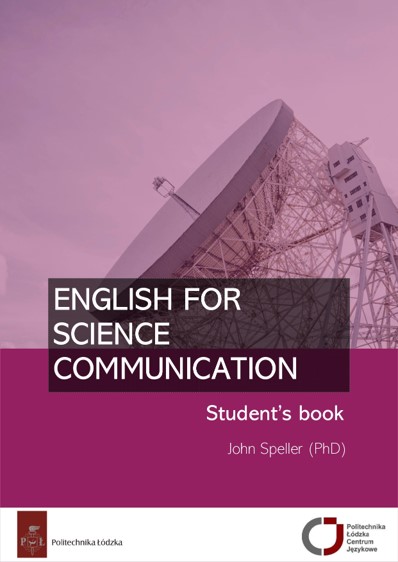Blog entry by dr John Speller
Overview
English for Science Communication is a coursebook designed for scientists, researchers, and students aiming to develop their skills in effectively communicating science to diverse audiences. The course emphasizes principles and practices essential for engaging both specialist and non-specialist audiences, fostering public understanding and appreciation of science.
The coursebook introduces key topics in science communication, including storytelling, visual representation of scientific data, public engagement strategies, and ethical considerations in communicating research. The materials include case studies, interactive activities, and multimedia content.
Audience: Undergraduate and master’s students in science-related disciplines
Responsibilities: Content creation, instructional design, eLearning development, visual design
Tools Used: MS Word, PowerPoint, Moodle
Process
The coursebook was developed using the ADDIE model (Analyze, Design, Develop, Implement, Evaluate), with iterative prototyping to ensure alignment with learner needs.
1. Analysis
Literature Review: To understand the needs and expectations of potential users, I conducted an extensive review of existing literature on science communication. This included academic articles, curriculum guides, and reports from leading organizations such as AAAS and UNESCO.
Key findings highlighted the importance of skills such as simplifying technical jargon, using storytelling techniques, and creating visuals that effectively communicate complex data.
The literature also emphasized the growing role of science communicators in addressing societal challenges and engaging with the public.
Benchmarking: I examined established science communication programs and frameworks to identify best practices and innovative approaches.
Learning Objectives: Clear objectives were defined, such as teaching students to:
- Identify and analyze their audience.
- Develop engaging narratives about scientific topics.
- Create impactful visual aids, including infographics and slides.
- Address ethical considerations in science communication.
2. Design
Curriculum Structure: Topics were organized into thematic units covering storytelling, audience analysis, visual communication, and public speaking for science. Each unit provided theoretical foundations, practical exercises, and opportunities for reflection.
Active Learning Focus: Activities such as role-playing, group discussions, and case studies were incorporated to help students practice real-world communication scenarios.
Capstone Assignment: The primary assignment was creating a 3–5 minute YouTube video. Students selected a scientific topic of their choice, tailored their message for a specific audience, and incorporated visuals and storytelling to produce an engaging video.
Activity Design: Each chapter included practical exercises, such as brainstorming video ideas, drafting scripts, designing visuals, and peer reviewing.
3. Development
Coursebook Content: Each chapter provided a blend of theory, practical exercises, and reflection prompts to guide learners in applying their skills to real-world scenarios.
PowerPoint Slides: Lesson slides were designed with clarity and engagement in mind, using visuals and concise text to facilitate in-class teaching.
Assignment Guidelines: Detailed instructions for the YouTube video assignment were included, covering steps from topic selection to editing tips.
4. Implementation
Classroom Delivery: The coursebook was used in face-to-face classes, where students could practice their skills and receive feedback.
Capstone Preparation: Students worked on their YouTube videos throughout the course, with milestones such as presenting storyboards, sharing drafts, and conducting peer reviews.
Showcase Event: At the end of the course, students presented their videos to the class, receiving feedback from peers and instructors.
5. Evaluation
Formative Feedback: Throughout the course, feedback from students was gathered through discussions and observations of their work to refine the course materials.
Assessment: Practical assignments and presentations were used to evaluate learning outcomes, ensuring that students could effectively apply the communication principles covered in the course.
Iterative Improvements: Based on evaluations, revisions were made to clarify concepts, enhance examples, and adjust exercises for improved engagement and understanding.
Results
By addressing real-world challenges in science communication, English for Science Communication equips learners with essential tools for effective, impactful communication.
